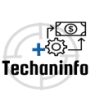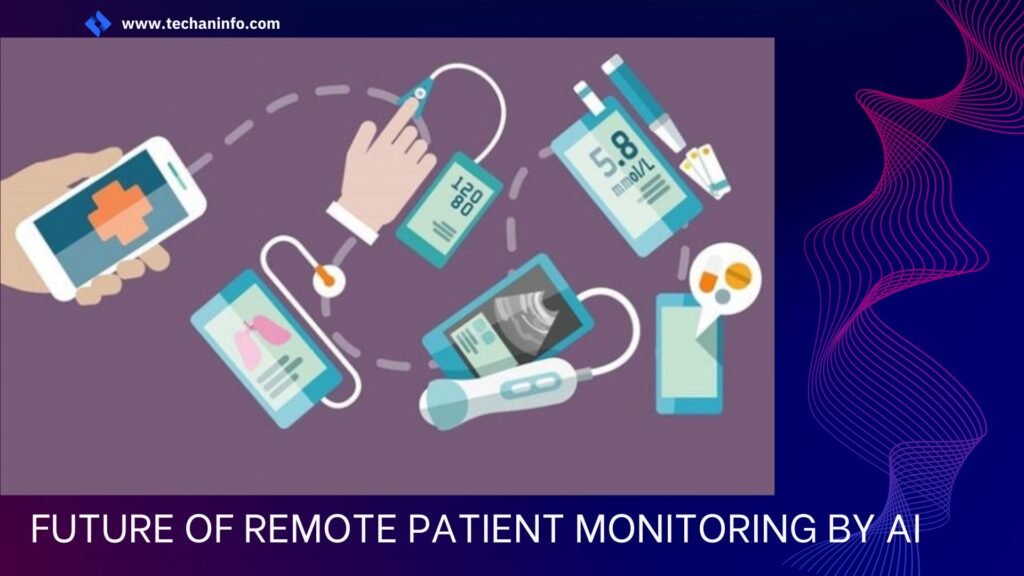
Table of Contents
Introduction
In recent years, remote patient monitoring has emerged as a powerful method in the medical industry, reshaping the communication between healthcare people and patients. With artificial intelligence (AI) advancements, remote patient monitoring has become even more effective and efficient. We will explore how artificial intelligence is helping in reforming remote patient monitoring by AI. This process provides benefits to healthcare industry and patients. Also, there are challenges at present in this way of tele-medication. Through improvement in AI & ML (machine learning models) with every passing day, the future looks bright. This will help manking to reduces its its challenges in the healthcare field in providing health servies to patients.
What is Remote Patient Monitoring?
Remote patient monitoring (RPM) refers to using technology to collect and monitor patient data outside of traditional healthcare settings. This empowers healthcare professionals to monitor patients important or lifesaving parameters or symptoms of health-related issues in almost real-time scenarios remotely. RPM allows for continuous patient health tracking, facilitating early detection of potential issues and proactive interventions.
Role Artificial Intelligence Plays In Remote Patient Monitoring By AI.
AI plays a crucial role in enhancing the capabilities of remote patient monitoring systems. Using machine learning algorithms and predictive analytics helps to analyze the vast amounts of health-related data in real-time patients. This helps the healthcare professional look for anomalies, trends or patterns. With this data and its analysis, healthcare people can suggest appropriate medications to their patients. Customized analysis of health data aids medical professionals in making appropriate decisions to provide personalized care for every patient. Through AI, repetitive medication to every patient for the same ailments can be reduced as each medical ailment affects differently in different patients. Factors affecting patients’ health can vary from lifestyle, race, age or gender etc. Therefore, AI helps provide a specialized medication roadmap for each patient.
Advantages of adopting Remote Patient Monitoring with AI
Remote patient monitoring by AI offers several benefits for both patients and healthcare providers:
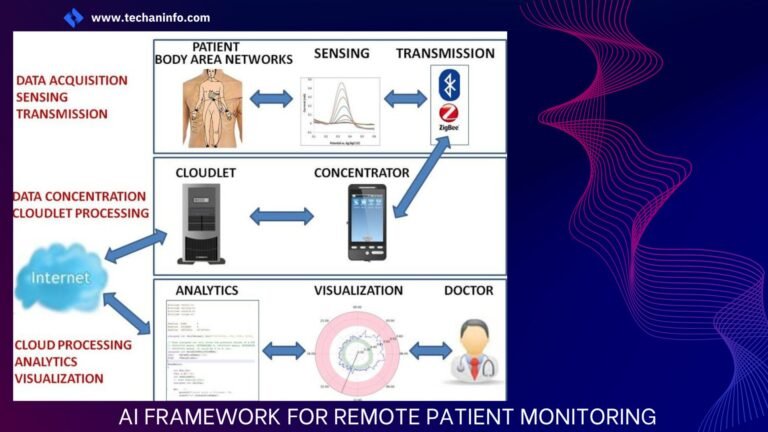
Improved Patient Outcomes
Remote patient monitoring with AI enables healthcare providers to monitor patients’ health continuously, leading to improved outcomes. Regular mapping remotely enables healthcare people to figure out any dangerous anomalies in health at the early stages.
This helps in timely intervention or sometimes preventive health diagnosis preventing risks and complications and even reducing the chance of hospitalization.
Enhanced Efficiency and Cost Savings
AI-powered remote patient monitoring systems streamline healthcare by automating data collection and analysis. This reduces the burden on healthcare providers and improves efficiency.
Additionally, remote patient monitoring by AI reduces regular visits of patients from their homes to the nearest health clinics or hospitals. Sometimes healthcare professionals need to visit home to collect data on patients, which is also reduced. Overall reduceing the burden of outdoor patients visits to hospitals for regular checkups. It also aids in taking care of critical patients by medical professionals as time is not wasted on checking regular patients.
Personalized and Proactive Care
AI algorithms can analyze patient data to identify individual patterns and trends and tailor interventions accordingly in analysis for every individual patient.
Providing customized medication by healthcare professionals ensures timely customised right care at appropriate time is provided to patients. This improvies patient satisfaction and overall health outcomes.
Early Detection of Health Issues
Through continuous monitoring and analysis of patient data, AI can detect subtle changes or abnormalities that might go unnoticed by healthcare providers.
Finding critical anomalies in the early stages helps in providing appropriate medication. It results in the slow progress of the life-threatening disease as its diagnosis is in the early stage. This can save patients’ life. Early finding of acute disease through the aid of AI helps in reducing the cost of medication a patient and his family have to undergo.
Remote Accessibility and Convenience
Remote patient monitoring by AI eradicates boundaries of location due to the geography where the patient is located. Thus allowing patients in remote or underserved areas to access quality healthcare.
It also provides convenience for patients with chronic conditions, as they can receive care from the comfort of their homes.
Difficulties in Deploying AI for Remote Patient Monitoring
While AI offers tremendous potential in remote patient monitoring, several difficulties are required to be overcome to obtain the fruits of AI in assisting the healthcare industry.
Data Security and Privacy
The collection and transmission of sensitive patient data raise concerns about privacy and security. Healthcare organizations must ensure robust security measures to protect patient information from unauthorized access or breaches.
Regulatory Compliance
AI-powered remote patient monitoring systems need to comply with healthcare regulations and standards. Following rules and suggestions from health care regulatory bodies to make successful ethical use of patient data. This promotes trust between patients, healthcare providers, and technology providers.
Integration with Existing Healthcare Systems
Seamless integration of AI systems with existing healthcare infrastructure is essential for effective remote patient monitoring. Interoperability and compatibility challenges must be addressed to ensure smooth data flow and communication between different systems.
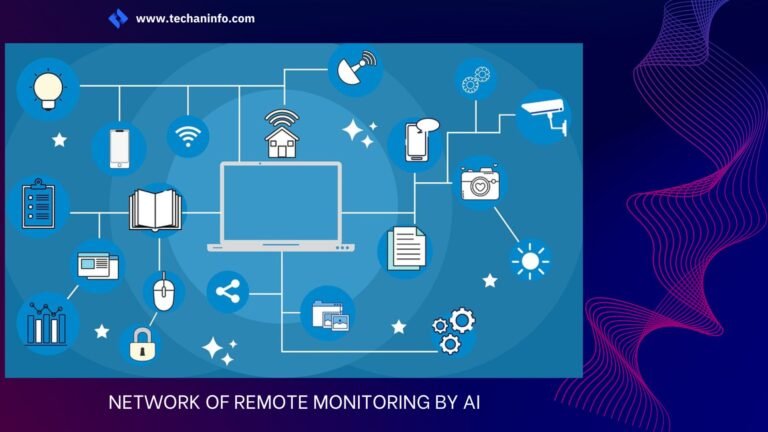
Privacy and Security Concerns
Privacy and security are paramount when implementing remote patient monitoring with AI. Healthcare organizations should prioritize the following:
- Implementing encryption and secure transmission protocols to safeguard patient data.
- Abiding by privacy rules of the law of the land ensures the health data security of patients and having consent from patients to use it for analysis.
- Regular cyber security audits evaluate the risk of a data breach, which ensures patients’ trust and helps to mitigate potential risks.
- Training healthcare staff on data privacy best practices to ensure responsible handling of patient information.
The Future of Remote Patient Monitoring
The future of remote patient monitoring looks promising, driven by advancements in AI and digital healthcare technologies. Here are some key trends to watch for:
- AI-driven Predictive Analytics: AI algorithms will become more sophisticated, enabling accurate predictions of patient health outcomes and identifying personalized treatment options.
- Wearable and IoT Devices: The use of wearable devices and Internet of Things (IoT) sensors will increase, allowing for continuous monitoring of vital signs and the collection of real-time patient data.
- Telemedicine Integration: Remote patient monitoring will seamlessly integrate with telemedicine platforms, providing comprehensive virtual care options for patients.
- Improved Patient Engagement: AI-powered systems will enhance patient engagement through personalized health recommendations, reminders, and interactive interfaces.
- Collaborative Healthcare Ecosystems: Remote patient monitoring will foster collaboration between healthcare providers, patients, and technology companies, leading to a holistic approach to healthcare delivery.
Remote Patient Monitoring CPT Codes:
Service Providers should know CPT codes for getting reimbursed or paid for services provided by them to patients:
CPT Code 99453
CPT Code 99453 is assigned to monthly remote monitoring of physiological parameters, which encompasses the supply of monitoring devices to patients to record and track their physiological data.
Description of CPT Code99453: Each month, remote monitoring involves continuous surveillance of one or more physiological parameters, providing necessary devices for patients to record and transmit data through daily recordings or programmed alerts.
CPT Code 99457
CPT Code 99457 is specifically designated to facilitate reimbursement for care coordination and foster physician-patient interaction in a remote setting. It requires a minimum of 20 minutes of virtual, interactive communication within a calendar month.
Description CPT Code 99457: In a given calendar month, remote physiologic monitoring treatment management services involve 20 minutes or more of dedicated time from clinical staff, physicians, or other qualified healthcare professionals. This time is spent engaging in interactive communication with the patient or caregiver.
CPT Code 99458
CPT Code 99458 accounts for each additional 20 minutes of interactive, virtual communication offered within a single calendar month as part of remote physiologic monitoring treatment management services.
Description: Remote physiologic monitoring treatment management services encompass the dedicated time of clinical staff, physicians, or other qualified healthcare professionals engaging in interactive communication with the patient or caregiver during a calendar month. Additionally, an extra 20 minutes of such communication is included.
CPT Code 99091
CPT Code 99091 is a code that measures time and encompasses the collection and interpretation of data by a physician or QHCP. It mandates a minimum of 30 minutes spent on this task.
Description: The process involves the gathering and analysis of digitally stored and/or transmitted physiologic data submitted by the patient or caregiver to the physician or other qualified healthcare professional (QHCP). This task necessitates a minimum of 30 minutes of dedicated time to be completed every 30 days.
These CPT codes help healthcare service professionals to determine their fees for services. Through CPT codes patients can decide also which health care service to opt for keeping their budget and health recovery path in consideration.
Remote Patient Monitoring Devices:
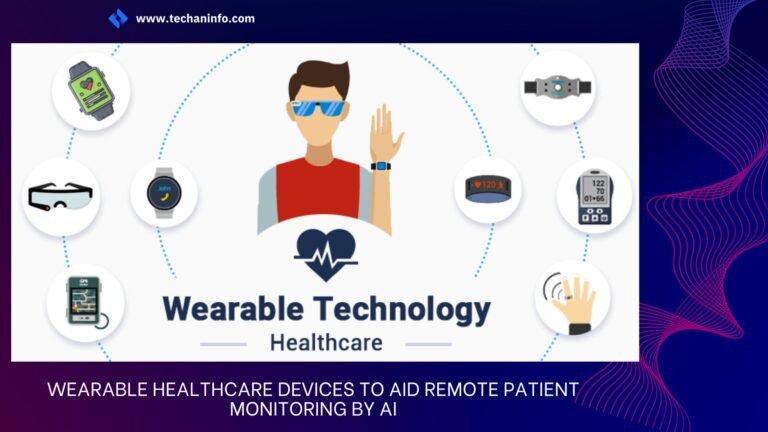
1. Blood Pressure Cuff:
Blood Pressure Cuff: determines a patient’s heart rate and blood flow by detecting variations in artery movement. The Bluetooth-enabled blood pressure cuff resembles the familiar one utilized at medical facilities, with the main distinction being its ability to transmit data instantaneously to the clinician for evaluation
2. Glucometer:
Glucometer: Glucometers analyze a patient’s blood sugar levels by utilizing a tiny blood sample applied to a connected test strip. The meter reads the blood sample on the test strip, generating a blood glucose reading. This reading is promptly transmitted to the healthcare provider for immediate review.
3. Pulse Oximeter:
Pulse Oximeter: The pulse oximeter is a clip that is non-invasively attached to the patient’s finger (or sometimes the earlobe) in order to gauge the light wavelengths that ascertain the blood oxygen level, indicating the amount of oxygen present in the patient’s red blood cells. Furthermore, the pulse oximeter records the patient’s pulse and sends them via Bluetooth connected to the WIFI network to concerned medical staff in real time for evaluation.
4. Hand Wearables:
Hand Wearables: Activity trackers allow healthcare providers to monitor their patients’ steps, heart rate, risk of falls, and even sleep patterns. They provide valuable insights into the patient’s daily routine, enabling providers to comprehend the impact of daily activities on the patient’s health and symptoms. The data gathered from these trackers aids providers in formulating the patient’s treatment plan. Popular activity trackers include the Garmin, Samsung and Apple Watches which have health monitoring features in them.
5. Weighing Scale:
Weighing Scale: By utilizing Bluetooth scales, patients can monitor the fluctuations in their weight over time, while healthcare providers can observe these changes to ensure that symptoms are not deteriorating. If symptoms do worsen, healthcare service providers can intervene accordingly.
6. ECG(Electrocardiogram):
- Biometric monitoring devices are utilized to digitally capture the heart and lung sounds of patients. This allows patients to self-monitor at home, while the readings from the electrocardiogram (ECG) or stethoscope are sent directly to the clinician for review. These readings are send in real time and doctors or concerned healthcare professional can advise patients remotely based on data.
7. Thermometer:
Thermometer: A Bluetooth thermometer quickly and accurately measures the patient’s body temperature, giving the provider crucial information to guide the next course of care.
These devices aids in the process of remote patient monitoring by AI.
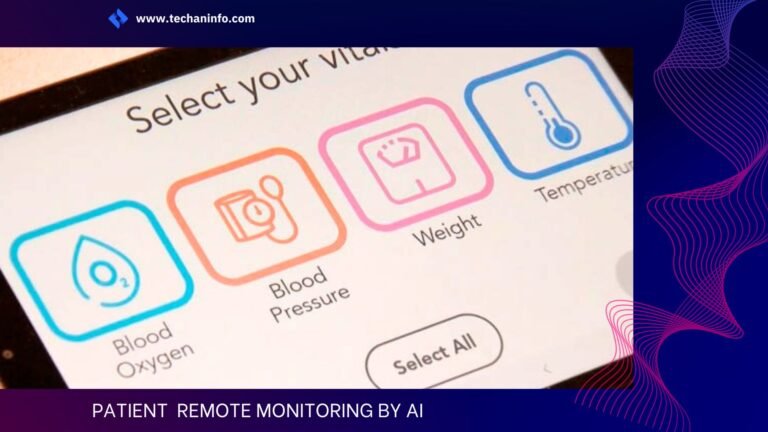
FAQ's (Frequently Asked Questions)
Q1: Is remote patient monitoring with AI only suitable for specific medical conditions?
No, remote patient monitoring with AI can be applied across various medical conditions. It particularly benefits chronic disease management, post-surgical care, and monitoring of high-risk patients.
Q2: How does AI ensure the privacy and security of patient data in remote monitoring?
AI systems utilized in remote patient monitoring are equipped with stringent security measures, encompassing advanced data encryption techniques and secure transmission protocols. The meticulous adherence to healthcare regulations guarantees patient data’s utmost protection and privacy.
Q3: Can remote patient monitoring replace in-person doctor visits entirely?
While remote patient monitoring can reduce the frequency of in-person visits, it is not intended to replace them entirely. In-person visits are necessary for specific examinations, procedures, and face-to-face consultations.
Q4: What are the potential financial benefits of AI-powered remote patient monitoring in terms of cost savings?
While remote patient monitoring can reduce the frequency of in-person visits, it is not intended to replace them entirely. In-person visits are necessary for specific examinations, procedures, and face-to-face consultations. But the reduction in the number of visits and more customised medical prescriptions based on real-time data analysis reduces the need for unnecessary tests and medicines. This results in overall cost savings for patients and also improves the efficiency of medical professionals as it reduces their overall work load.
Q5: How can patients access remote patient monitoring services?
Patients can access remote patient monitoring services through specialized apps, web platforms, or wearable devices. These tools enable data collection, transmission, and communication with healthcare providers. This real time observations of patients vital health parameter reduces risk for patients and makes medicaiton more effective aiding in early recovery of patients.
Conclusion
AI-powered remote patient monitoring has the potential to transform the healthcare delivery system by providing continuous, personalized, and proactive care. With improved patient outcomes, enhanced efficiency, and cost savings, this technology is poised to revolutionize the healthcare industry. However, addressing challenges varying from risk to data authenticity, and abiding by healthcare data framework rules needs to be worked upon in the coming times. Finally, incorporating all these in a robust system is a vital part of obtaining successful outcomes from remote patient monitoring by AI.
